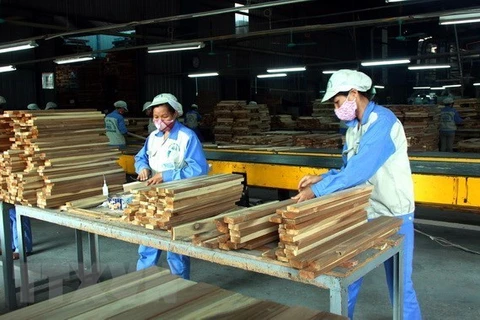 Exporters of wooden furniture are trying to shift to markets less affected by inflation such as Japan and the Republic of Korea (RoK). (Photo: tuoitre.vn)
Exporters of wooden furniture are trying to shift to markets less affected by inflation such as Japan and the Republic of Korea (RoK). (Photo: tuoitre.vn) In fact, Vietnam’s wood industry is seeing declining sales overseas.
The export value in July was estimated at 1.41 billion USD, down 5.5% against June and down 1.6% year-on-year, according to a report of the General Department of Forestry under the Ministry of Agriculture and Rural Development (MARD).
This was the second month that the export of wood and timber products decelerated.
Earlier, figures from the General Department of Customs showed the export turnover of wood and wood products in June was down nearly 11% year-on-year. Through the first seven months of the year, wood and wood product exports were 10.4 billion USD, up just 1.3% year-on-year.
According to market insiders, the wood industry will face a big challenge due to a decrease in export orders in the latter half of this year.
A quick survey on 52 timber businesses conducted by the Vietnam Timber and Forest Products Association (Vifores) in collaboration with Forest Trends showed that most companies witnessed decreasing revenues in the US, EU and UK markets.
Thirty-three out of 45 firms exporting to the US said their revenues decreased by nearly 40% compared to the first months of this year. A similar trend is seen in the EU and the UK, with two-thirds of the surveyed enterprises reporting revenue drops of over 41%.
Moreover, about 71% of businesses said that orders will continue to decrease towards the end of the year. Under the current market situation, 44% of businesses expected revenue will fall by about 44% for the whole year.
Phung Quoc Man, general director of Bao Hung Wooden Furniture Export Company, said the number of orders canceled in July was more than 30%. In response to the decline in purchasing power in the EU and the US markets, the business is looking to boost furniture exports to Japan and the Republic of Korea, where inflation has had less of an impact than in other countries.
There are also a few businesses that turn to the domestic market in order to maintain production, Man said.
According to the Vifores Chairman Do Xuan Lap, Vietnam's wood industry is integrating deeply into international markets so high inflation and tightening credit policies in response to rising inflation in major markets is driving down demand for non-essential products including wood and wood products.
“High inflation in major markets such as the US, EU and UK is having a direct negative impact on the production and business activities of wood processing enterprises. They are currently facing many difficulties in terms of capital, labour costs and input materials,” Lap said.
Switching or finding new markets is not easy, but this helps wood and wooden furniture manufacturers minimise losses when a series of orders are stretched, reduced, or even canceled by international partners, Man said.
In addition, in order to reduce the import price of raw materials to increase competitiveness, experts said wood businesses should diversify their supply of timber, reducing the proportion of imports from tropical countries and increasing the proportion from low-risk sources.
Vietnam has become the world’s sixth largest exporter of wood and wooden products with more than 4% of the global market, second largest in Asia, and biggest in the Southeast Asia, putting it under scrutiny from major trading partners.
Besides sourcing locally, Vietnam also imports raw timber, including from tropical countries. The volume of tropical wood imported annually is around 1.5 million cubic metres, or 30% of total imports, mostly from Africa.
According to statistics from the General Department of Customs, despite the impact of the COVID-19 pandemic, exports of wood and wooden products grew by 17.6% last year to 14.12 billion USD.
Vietnamese wood and wood products are present in more than 163 countries.
Vietnam is targeting 20 billion USD in total timber exports by 2025, an increase of more than $9 billion compared to now.
The value of timber and wood products for domestic consumption will reach $5 billion in 2025 and over $6 billion in 2030.
The industry aims to have more than 80% of wood processing and preservation establishments equipped with advanced technology, and all timber and wood products for export and domestic consumption will be made from the legal raw material of timber.
By 2030, the domestic wood processing industry will become an important economic sector and develop a reputable brand for Vietnamese wood products in domestic and export markets.
Vietnam strives to become one of the leading countries in the world's production, processing, and export of timber and wood products.
Another task of the industry is to develop infrastructure and expand production scale. Specifically, the industry will form five forestry zones with high technology applications to attract investment from wood processing enterprises and enterprises producing auxiliary materials.
Vietnam will build an international furniture exhibition centre and encourage the development of research centres to design wood products per the needs of consumers./.
VNA






















